What is the Best Watch Sized Diving Computer in 2025?
More and more scuba divers are choosing a watch sized diving computer as improving technology allows more powerful and varied functionality to be squeezed into dive instruments that can be worn day-to-day.
Diving computers tend to be a big investment, so it’s critical that you have the right information to choose the best option for your needs as a diver. In this article, I will give you the details and specifications needed to make the best-informed choice.
What are the different types of watch sized diving computers?
There are two categories of watch sized diving computers:
- Smart watch
- Basic watch
Some computers offer a huge range of smart functionality; everything you might expect to find on a latest generation watch, including:
- GPS
- Heart rate monitors
- Blood oxygen sensors
- Music players
- Bluetooth connection for linking wireless headphones, smartphones, and internet music streaming services.
- Other models have nothing more than basic watch functionality on dry land.
What dive functionality do watch sized diving computers have?
In terms of dive functionality, there can be big differences in watch sized diving computers. High-end models offer all the functionality necessary for trimix technical and CCR diving.
More economical models are restricted to recreational diving, without options for helium or multiple gas mixtures.
Different decompression models
A majority of watch sized diving computers use the Bühlmann ZH-L16 algorithm to plan and conduct dives. This is the most popular decompression model with higher-level divers; especially those doing technical dives.
Some manufacturers use proprietary models that may be more conservative or adaptive on the dive – which makes them unpredictable for tech diving.
Air integration (AI)
The other big difference in functionality amongst watch sized diving computers is whether they utilize air integration (AI) or not.
The use of transmitters to monitor gas supplies and predict remaining gas consumption time is becoming very popular in the dive community.
Some AI-capable computers permit just one transmitter, while others can link with multiple transmitters; making them attractive to sidemount or technical divers.
How much do watch sized diving computers cost?
The cost for a watch sized diving computer ranges from $299 to well over $1500. The price typically reflects the level of functionality provided by the computer, along with the materials used in construction. Smart watches cost more than basic watches.
High-end watch sized dive computers
Computers manufactured from titanium or stainless steel tend to cost more than those made from Delrin and other composites. Likewise, screen material has a cost effect. Some are plastic, whilst others are mineral glass or sapphire crystal; which are increasingly more scratch-resistant and durable.
Air integration costs more
If you are seeking air-integration functionality, do remember that you’ll also have to budget for the cost of the transmitters. These are typically sold separately by manufacturers; with prices usually starting at ~$500.
What are the best watch sized diving computers?
Here’s my list of the best watch sized diving computers currently on the market. Use the information provided to decide which computer best suits your individual diving needs and financial budget.
- Shearwater Teric *best for tech diving
- Shearwater Tern *best for recreational diving
- Garmin Descent Mk2 *best smartwatch
- Garmin Descent G1 Solar *best mid-range
- Deep6 Excursion *best economy range
- Garmin Descent Mk1
- Cressi Neon
- Ratio iDive Color Tech+
- Suunto D5
- Aqualung i470TC
- Suunto D41 Novo
- Suunto DX Titanium
- Apple Watch Ultra Oceanic+
Best Watch Sized Diving Computer For Technical Diving
Shearwater Teric
- Algorithm: Bühlmann ZH-L16 with Gradient Factors
- PC Link: Bluetooth Smart LE
- No. Gasses: 5 + CCR mode
- Air Integration: 4 transmitters
- Depth Rating: 200m
- Screen Type: 1.39″(400 x 400 pixel) Full Color AMOLED
- Battery: Rechargeable docking Li-ion Battery; Dive Mode 30+ hours / Watch Mode 50+ hours
- Strap: Silicon 22mm standard, with multiple color options available
- Materials: Ballistic nylon polymer case and 316 Stainless bezel/buttons with sapphire crystal screen
- Compass: 3D digital compass
- Price: ~$1150
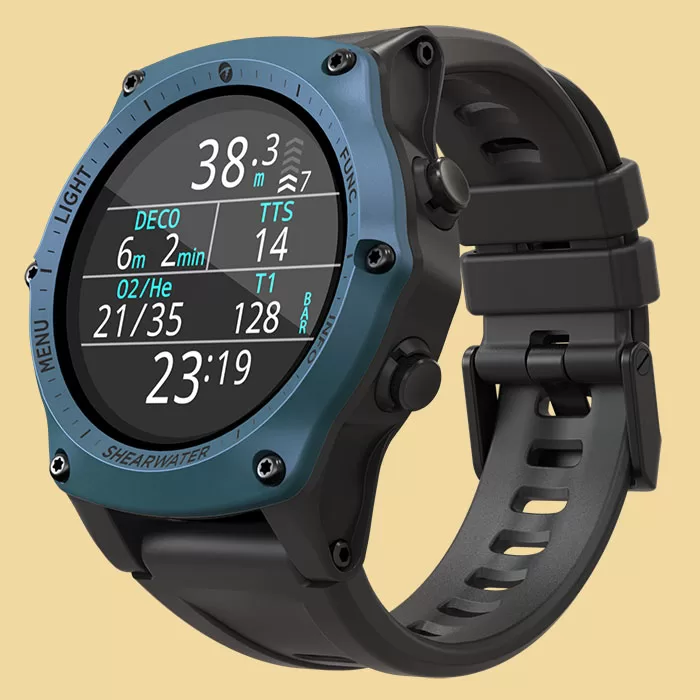
The Teric has open-circuit recreational, open-circuit technical, CCR, gauge and freediving modes.
You can connect up to four AI transmitters for wireless gas tracking and the screen display is vibrant and easy to view, even in bright conditions with a lot of glare.
Shearwater are incredibly popular
Shearwater energized the market with its release of the Teric in 2018. It’s been a firm favorite of many divers ever since. This watch sized diving computer squeezes in all of the functionality and firmware that you’d be accustomed to seeing on Shearwater’s full-size models, like the Petrel, Perdix, and Peregrine. I know numerous technical divers who use it as either a primary or backup computer for serious decompression diving.
A more dedicated diving instrument than Garmin
Whilst the Teric doesn’t have the vast suite of sports and outdoors features offered by its competitor, the Garmin Descent (see below), it is significantly more functional as a dedicated recreational and technical diving computer; especially in regards to the in-water information supply; such as the GF99, GFSurf, tissue compartment graphs displays.
As a technical diving instructor, I find that detailed information indispensable on my dives; and it has safety benefits in respect to on-the-fly decision-making.
Learn how to use these functions in my exclusive ebook:
Become A Shearwater Power User! (eBook)
An Illustrated Guide to Gradient Factors and Advanced Shearwater Computer Settings for safe scuba diving.
42 Pages. Printable PDF format. Fully Illustrated. $9
Become A Shearwater Power User eBook
As featured on the DiveTalk Podcast
It’s worth noting that Shearwater has an exceptional reputation amongst the dive community for their customer service. This factor alone is why many divers choose to invest in their computers.
Product Link:
Product Manual:
Best Watch Sized Diving Computer For Recreational Diving
Shearwater Tern and Tern TX
- Algorithm: Bühlmann ZH-L16 with Gradient Factors
- PC Link: Bluetooth
- No. Gasses: 3 gas
- Air Integration: 4 transmitters
- Depth Rating: 120m / 394ft
- Screen Type: 3.3cm / 1.3″ 360 x 360 full colour AMOLED
- Battery: Rechargeable docking Li-ion Battery; up to 20 hours (medium brightness), up to 6 months (standby)
- Strap: 22mm strap size with quick connect (one long and one short strap included)
- Materials: Ballistic nylon polymer case and 316 Stainless bezel/buttons. Toughened glass screen.
- Compass: Tern TX only – 3D digital compass
- Price: Tern $650 / Term TX $775 + transmitter cost
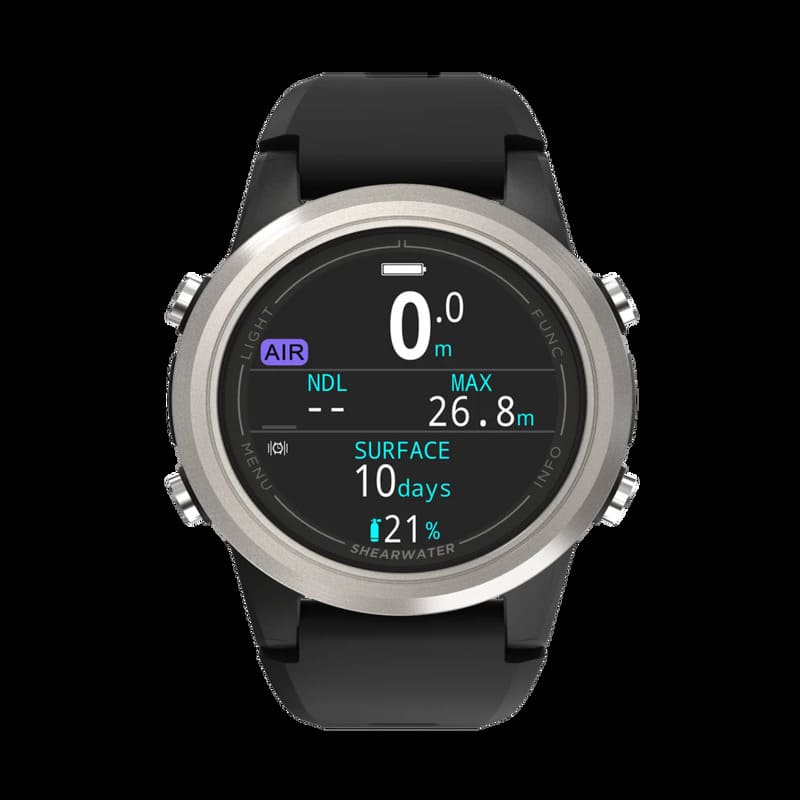
The Shearwater Tern is an economical option designed for recreational divers; not possessing the trimix capability offered by the Teric. However, it still retains the same UI, information display, and legendary customer service for which Shearwater is respected.
Divers who wish to use air integration (AI) and/or a digital compass can opt for the Tern TX version. This allows up to 4 Shearwater transmitters to be connected for gas monitoring.
Product Link:
Product Manual:
Best Watch Sized Diving Computer For Non-Diving Functions
Garmin Descent 51mm Mk3i
- Algorithm: Bühlmann ZH-L16c with Gradient Factors
- PC Link: Bluetooth® Smart, ANT+®, Wi-Fi®
- No. Gasses: 11 + CCR mode
- Air Integration: 8 transmitters
- Depth Rating: 200m
- Screen Type: 1.4” (454 x 454 pixels) AMOLED colour
- Battery: Rechargeable Li-Ion with proprietary clip charger: 25 days in smartwatch mode, 66 hours in dive mode (40 hours for Mk2i using transmitters), and 55 hours in GPS mode.
- Strap: 22mm QUICKFIT™ Silicone
- Materials: Fiber-reinforced polymer case with titanium rear cover and diamond-like carbon (DLC) coated titanium and scratch-resistant sapphire crystal screen
- Compass: 3D digital compass
- Price: $1599 (51mm Mk3i)
Garmin released two new models of the Descent Mk3 in November 2023: the Mk3 and Mk3i (air integration). The Garmin Descent Mk3i model is available in two sizes, a smaller 43mm or a large 51mm. The larger size watch offers more functionality, a significantly larger screen, and much longer battery life. Additionally, the 51mm Mk3 has a built-in LED light, with strobe function, for emergencies.
In addition to all of the functionality offered on the older Mk2 (see below), the new 51mm Mk3i has a larger screen with much higher resolution and allows up to 8x T2 transmitters to be connected. This can allow inter-diver monitoring and can also enable preset diver-to-diver messaging (Subwave Sonar Messaging).
Technical divers may appreciate the improved depth rating of the Mk3, with 200m of pressure resistance, rather than the 100m of the Mk2.
New software apps on the M3i include a ‘Dive Readiness Tool‘ which monitors your biodata pre-diving to suggest DCS susceptibility, and ‘DiveView Maps‘ showing depth contours for over 4000 dive sites around the world.
Garmin Descent 43mm Mk3 and M3i
- Algorithm: Bühlmann ZH-L16c with Gradient Factors
- PC Link: Bluetooth® Smart, ANT+®, Wi-Fi®
- No. Gasses: 11 + CCR mode
- Air Integration: 8 transmitters (Mk3i only)
- Depth Rating: 200m
- Screen Type: 1.2” (390 x 390 pixels) AMOLED colour
- Battery: Rechargeable Li-Ion with proprietary clip charger: up to 12 days in battery-saver watch mode, 10 days in smartwatch mode, 30 hours in dive mode (15 hours for Mk2i using transmitters) and 20 hours in GPS mode.
- Strap: 22mm QUICKFIT™ Silicone
- Materials:
- Mk3: Fiber-reinforced polymer case with a stainless steel bezel and sapphire crystal screen.
- Mk3i: Fiber-reinforced polymer with titanium rear cover, Diamond-like Carbon (DLC) coated titanium or bronze PVD coated titanium bezel, and sapphire crystal screen.
- Compass: 3D digital compass
- Price: $1399 (43mm Mk3i) and $1199 (43mm Mk3)
There are two models available in the 43mm size; with air-integration (Mk3i) and without (Mk3).
The Garmin Descent 43mm Mk3 is slightly smaller than the older Mk2 (43x43x14.15mm versus 52x52x17.8mm), which may be desirable for smaller divers. However, it also has a smaller screen size (1.2″ vs 1.4″) which some may find less easy to read.
The disadvantage of a smaller screen size is somewhat balanced by a significantly higher resolution compared to the Mk2 (390x390px versus 280x280px).
One of the biggest drawbacks of the 43mm version of the Mk3 is its shorter battery life compared to the 51mm model. You will need to recharge far more frequently. Additionally, the small version of the Descent Mk3 does not feature an in-built LED emergency light.
Garmin Descent Mk2/Mk2i/Mk2S
- Algorithm: Bühlmann ZH-L16c with Gradient Factors
- PC Link: Bluetooth® Smart, ANT+®, Wi-Fi®
- No. Gasses: 12 + CCR mode
- Air Integration: 5 transmitters (Mk2i only)
- Depth Rating: 100m
- Screen Type: 1.4” (280 x 280 pixel) sunlight-visible, transflective memory-in-pixel (MIP)
- Battery: Rechargeable Li-Ion with proprietary clip charger: up to 50 days in battery-saver watch mode, 16 days in smartwatch mode, 80 hours in dive mode (32 hours for Mk2i using transmitters) and 24 hours in GPS mode.
- Strap: 22mm QUICKFIT™ Silicone or Titanium (Mk2i)
- Materials: Fiber-reinforced polymer case with a stainless steel (Mk2/Mk2S) or Titanium bezel (Mk2i) and scratch-resistant sapphire crystal screen
- Compass: 3D digital compass
- Price: Mk2 $1299/ Mk2i $1499 / Mk2S: $999
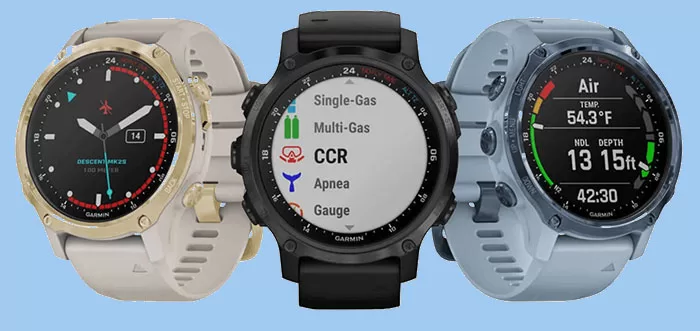
The Garmin Descent Mk2 is a full function trimix computer, with added functionality as a fully smartphone compatible (with smart notifications and controls) outdoors, fitness and sports watch.
Whilst the Teric is a dedicated technical diving computer with a lot of the excellent diving functionality you’d see in Shearwater’s full-size devices, the Garmin Descent Mk2 is much more of an all-round, watch sized diving computer.
The Garmin will appeal to those who also want the features of both a modern smart-watch and a highly capable sports/outdoors instrument; in addition to being an excellent dive instrument.
In dive mode it offers forty customizable alarms, has three conservatism settings plus custom settings for gradient factors, and has several safety stop options, including custom stop settings. It has a CCR diving mode.
The Descent Mk2 is available in black, light gold and mineral blue colors.
A vast array of sports and outdoors functions
It features a vast array of sensors, including; GPS, GLONASS, constant heart rate monitor, blood oxygen (spO2) sensor, barometric altimeter, compass, gyroscope, accelerometer and thermometer.
These allow specific multisport operating modes, which can be linked to the internet via a smartphone, for swimming, cycling, golf, fitness tracking, running, and outdoors (hiking/climbing, mountain biking, skiing, snowboarding, rowing, jumpmaster and tactical).
You can download digital maps onto the watch, for use with the abovementioned modes, and record the entry and end points of your dive using GPS/GLOSNASS/Galileo satellite systems.
It has a music player feature (2000 songs storage); you can link bluetooth headphones and connect to streaming apps, like Spotify. The Descent Mk2 is also smartphone compatible with Android and iPhone.
The Mk2S and Mk2i versions
Mk2S version: The Mk2s is smaller in size; 43mm compared to the other options which have a 52mm case size. It has a smaller screen diameter of 1.2″ (240 x 240 pixels) and weighs just over 100 grams/2oz (silicone band: 60 g/ case 41g). It is available in three color options.
Mk2i version: The Mk2i has air integration (AI) technology and links to Garmin’s T1 gas transmitters; this tracks your gas consumption and provides information on the remaining time available. It has functionality to pair with up to five different transmitters, which are sold separately. The watch has a Diamond-like Carbon (DLC) coated titanium bezel and option for a titanium metal strap. It weighs silicone band: 99.6 g with a silicon band and 160.3g with the titanium band.
Additional apps can be installed via Garmin’s online store.
Product Link:
2. Descent Mk2S – small size option
3. Descent Mk2i – air integration/titanium
Product Manual:
Best Mid-Market Watch Sized Diving Computer
Garmin Descent G1 Solar
- Algorithm: Bühlmann ZH-L16 with Gradient Factors
- PC Link: Bluetooth Smart, ANT+ and Wi-Fi
- No. Gasses: 12
- Air Integration: none
- Depth Rating: 100m
- Screen Type: two-window design: 0.9” x 0.9” (176 x 176 pixel) monochrome sunlight-visible, transflective memory-in-pixel (MIP)
- Battery: Rechargeable Li-Ion with proprietary clip charger: unlimited with solar watch mode, 4 months in smartwatch mode, 25 hours in dive mode and 26 hours in GPS mode. Solar charging, assuming all-day wear with 3 hours per day outside in 50,000 lux conditions
- Strap: QUICKFIT™ Silicone (22 mm)
- Materials: Fiber-reinforced polymer case and bezel, with ‘Power Sapphire’ screen
- Compass: 3D digital compass
- Price: ~$650

The Garmin G1 solar has all of the functionality of the Mk2, but offers solar recharging. This dramatically extends the amount of time between necessary charging. The computer has a smaller screen size and a monochrome display. It is available in black and hurricane blue colors. The G1 Solar is the only solar powered watch sized diving computer on the market.
Additional apps can be installed via Garmin’s online store.
Product Link:
Product Manual:
Garmin Descent G1 Solar Manual
Best Economy Range Watch Sized Diving Computer
Deep6 Excursion
- Algorithm: Bühlmann ZH-L16c
- PC Link: Bluetooth 5.0
- No. Gasses: 1 (Nitrox 21%-56%)
- Air Integration: none
- Depth Rating: 100m
- Screen Type: 1.4″ (110 x 110 pixel)
- Battery: Rechargeable Lithium with clip-style charging. 25 hours with backlight active in dive mode and 3 months in standby watch mode
- Strap: Nylon (NATO-style)
- Materials: 316 Stainless Steel case and bezel with K1 tempered glass screen
- Compass: none
- Price: $299
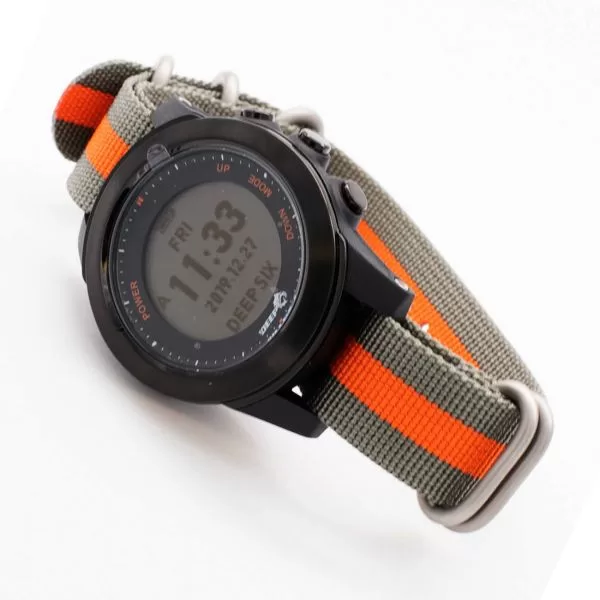
BEST BUDGET BUY. The Deep6 Excursion isn’t comparable with watch sized diving computers like the Shearwater and Garmin, but it only costs a fraction of the price and provides everything the average recreational diver needs.
It has air, nitrox, gauge and apnea/free-diving modes, It doesn’t have custom gradient factors, but there are three conservatism settings, based upon GF 35/75, 40/85, 45/95.
Product Link:
Product Manual:
Garmin Descent Mk1
- Algorithm: Bühlmann ZH-L16 with Gradient Factors
- PC Link: Bluetooth Smart, ANT+ and Wi-Fi
- No. Gasses: 6
- Air Integration: none
- Depth Rating: 100m
- Screen Type: 1.2″ (240x 240 pixel) sunlight-visible, transflective memory-in-pixel (MIP)
- Battery: Rechargeable Li-Ion docking type: up to 19 days in watch mode, 10 days in smartwatch mode, 40 hours in dive mode and 20 hours in GPS mode4
- Strap: Silicone or Titanium
- Materials: Fiber-reinforced polymer case with a stainless steel or Titanium bezel and scratch-resistant sapphire crystal screen
- Compass: 3D digital compass
- Price: ~$999 (expect to pay ~$700 pre-owned)

The Garmin Descent Mk1 was superseded by the Mk2, but they are still being sold by some retailers and many are becoming available on the second-hand market as divers upgrade to newer versions.
Despite not being Garmin’s latest model, the Mk1 remains very competitive against other watch sized dive computers on the market.
The Mk1 is also a full function trimix computer, with added functionality as a fully smartphone compatible (with smart notifications and controls) outdoors, fitness and sports watch.
Additional apps can be installed via Garmin’s online store.
Product Link:
Product Manual:
Cressi Neon
- Algorithm: Cressi RGBM
- PC Link: Bluetooth
- No. Gasses: 2 gas (21-99% O2)
- Air Integration: None
- Depth Rating:120m / 395ft
- Screen Type: 1.4″ (37mm) monochrome with backlight
- Battery: User replaceable 3V CR2450 battery
- Straps: PTU rubber wristband with stainless steel buckle
- Materials: Mineral glass screen, stainless steel crown and buttons, with a plastic-type body
- Compass: None
- Price: ~$374
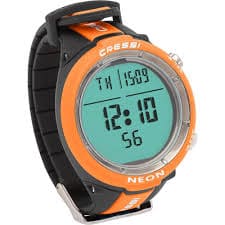
The Cressi Neon is one of the most simplified and economical watch sized computers on the market. Firmly aimed at recreational divers, it provides the basic diving information needed for safety. The RGBM algorithm won’t be popular with more advanced divers, but it is a common choice for recreational computers.
It is available in a wide range of color options: black, blue, gray, red, green, orange, and white/lilac. Other features include; a stopwatch, audible alarms, manual backlight, an alarm clock function. The Cressi Neon has 3 modes: air/nitrox, free dive and gauge.
Product Link:
Product Manual:
Ratio iDive Color Tech+
- Algorithm: Bühlmann ZH-L16B w/GF and VPM-B (switchable)
- PC Link: USB
- No. Gasses: 10 (Air, Nitrox, Trimix, CCR)
- Air Integration: 10 transmitters (+ auto-switch sidemount mode)
- Depth Rating: 220mt / 721ft
- Screen Type: TFT LED w/IPS, 1.3″ (240×240 pixel) 261 ppi
- Battery: USB rechargeable Li-Ion (25 hours in dive mode)
- Straps: Polymer (multiple color options available)
- Materials: Sapphire Crystal screen with Stainless steel bezel and case.
- Compass: 3D digital compass
- Price: ~$999
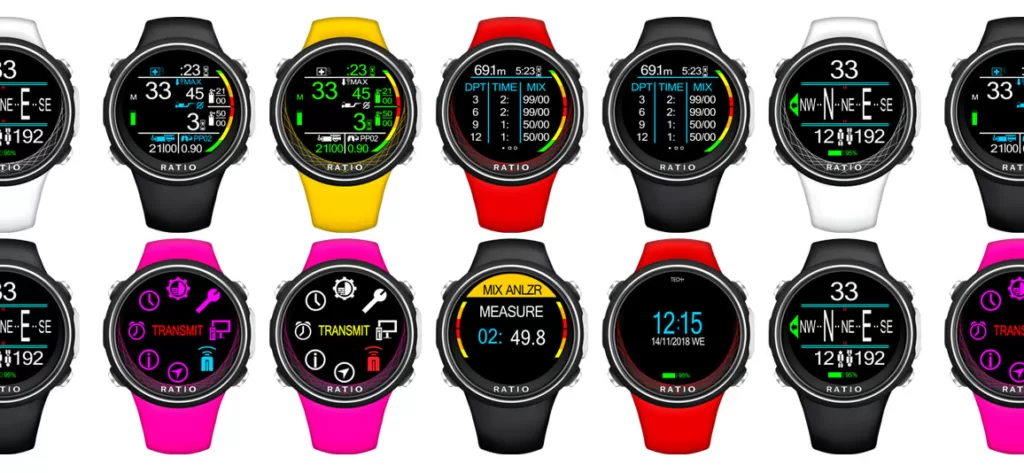
The iDive Color Tech+ is the new 2019 flagship of Ratio’s watch sized diving computer range. It is programmed for full trimix capability and comes with many of the features you’d find on their full-sized iX3M range.
In terms of price, it is competitive with the Suunto D5 and Garmin Mk2S, Mk1 and G1 Solar computers.
The top-of-the-range Color Tech+ comes with a sapphire crystal screen. This material is second only to diamond with respect to hardness and scratch-resistance and improves the depth rating of the Tech+ to 220m compared to the Easy and Deep variants which have mineral glass screens.
An atypical choice of decompression model
As with the iX3M, the iDive Color Tech+ opts for the Bühlmann ZHL-16B algorithm; which was originally designed to produce dive tables, unlike the ‘C’ version which is intended for implementation on dive computers. The Ratio will be less conservative than other computers using Buhlmann version C.
You’ll find it has all the standard Ratio gadgets: magnetometer, luxmeter, altimeter, moon calendar, chronometer, pitch/roll display, weather forecast and barometer. It also features an (optional) USB plug-in O2 analyser and has integral gas-blending software installed.
Fancy color-coded LED transmitters
The unit is wireless air integration and illuminating colour-coded transmitters can be purchased. The illuminating transmitter LEDs are also color-coded to warn of gas pressure; Green = 100+ bar / Yellow = 50-100 bar / Red = 0-50 bar. The tech community generally hasn’t adopted air-integration yet, so I doubt this would be a valuable functionality for many buying the Color Tech+. Also, for cave and wreck divers, all those sparkly transmitter LEDs are liable to be distracting in dark environments.
More affordable models are available
Ratio also offers more economical models, restricted for nitrox or normoxic trimix diving only:
- iDive Color Easy – 2 gasses (air/nitrox), 6x Bühlmann ZHL-16B pre-set (not user definable)
- iDive Color Deep – 3 mixes (air/nitrox/normoxic trimix), 6x Bühlmann ZHL-16B pre-sets (not user definable) and 6x VPM-B pre-sets.
Recreational divers can set their own preferences for deep stops (standard or Pyle method) and can manually input/designate what method of safety stops they want to complete.
Product Link:
Product Manual:
Suunto D5
- Algorithm: Suunto Fused™ RGBM-2
- PC Link: USB and Bluetooth Smart
- No. Gasses: 3
- Air Integration: 1 transmitter
- Depth Rating: 100m
- Screen Type: LED (320×300 pixel) memory in pixel (MIP)
- Battery: rechargeable lithium-ion. 6-12 hours in dive mode and 6 days in watch mode
- Mounting: silicon (24mm), multiple color options and NATO-style strap is available
- Materials: Reinforced composite case, stainless steel bezel and mineral glass screen
- Compass: yes
- Price: ~$914
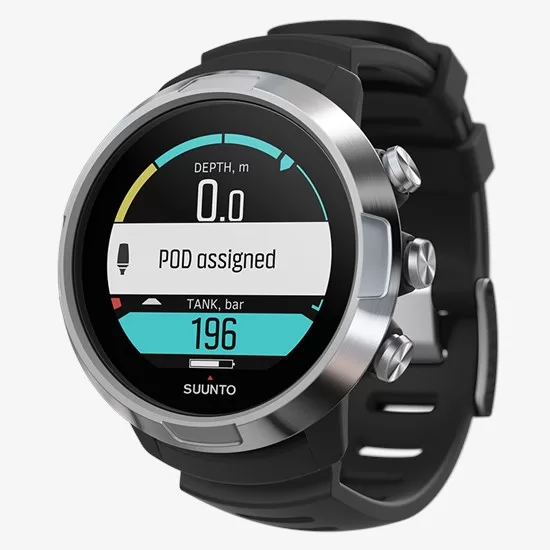
Suunto dive computers are very popular in the recreational dive community. The D5 watch sized diving computer has a modern full-color screen, a rechargeable battery, and offers air integration with one transmitter.
The D5 competes with the Ratio iDive Color Tech+ and Garmin Mk25S in terms of price.
It used Suunto’s latest proprietary algorithm, Fused RGBM-2, which is designed to cater for deeper technical dives and CCR diving.
Suunto claims the algorithm is less conservative and more tolerant of repetitive diving than their standard RGBM algorithm; which makes this watch sized diving computer more appealing to experienced divers.
Product link:
Product Manual:
Aqualung i470TC
- Algorithm: proprietary Z+ (with deep stops) based upon Bühlmann ZHL-16c
- PC Link: Bluetooth and USB
- No. Gasses: 3
- Air Integration: 3 transmitters
- Depth Rating: 120m
- Mounting: silicon, multiple color options
- Materials: Reinforced composite case, stainless steel bezel and mineral glass screen
- Screen Type: no details given by the manufacturer
- Battery: User-changeable standard CR2430 lithium watch battery
- Mounting: silicon
- Materials: no details given by the manufacturer (appears nylon with glass screen)
- Compass: none
- Price: $525
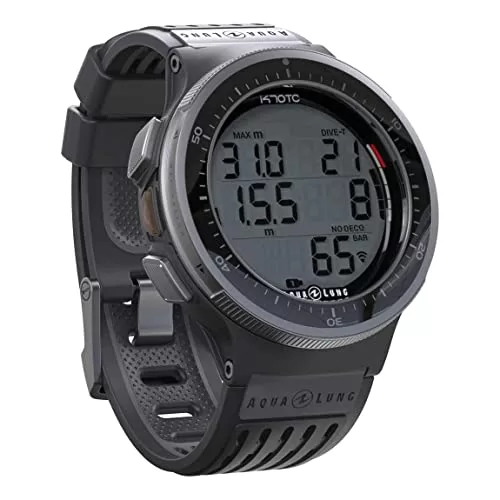
The Aqualung i470TC appears old generation in terms of its screen display; and Aqualung cleverly omit to mention any details of the screen resolution or case/bezel/screen materials. It is a glaring omission and seems disingenuous. Divers looking to invest in a watch sized diving computer need manufacturers to supply them with full details for comparisons.
The screen display may appeal to divers who prefer a retro ’80s style digital watch style. In my own inspection, it seems to be a nylon-type case with a glass screen. They provide a plastic screen protector in the box.
The i470TC is the only economy range (~$500) watch sized dive computer that offers air integration (AI) capability with more than one transmitter. The algorithm is based upon Bühlmann ZHL-16C, but has been modified to enable deep stop functionality.
Diver reports suggest that the algorithm tends to be conservative; which makes it ideal for novice divers. I personally don’t like proprietary algorithms on my dive instruments; as they aren’t transparent about how they perform.
Product link:
Product Manual:
Suunto D41 Novo
- Algorithm: Suunto RGBM
- PC Link: USB and inductive
- No. Gasses: 1
- Air Integration: 1 transmitter
- Depth Rating: 100m
- Screen Type: LCD matrix (49×22 pixel) with electro-luminescent backlight
- Battery: CR2450 watch battery
- Mounting: silicon (24mm), multiple color options and NATO-style strap is available
- Materials: Reinforced composite case, stainless steel bezel and mineral glass screen
- Compass: yes
- Price: $499
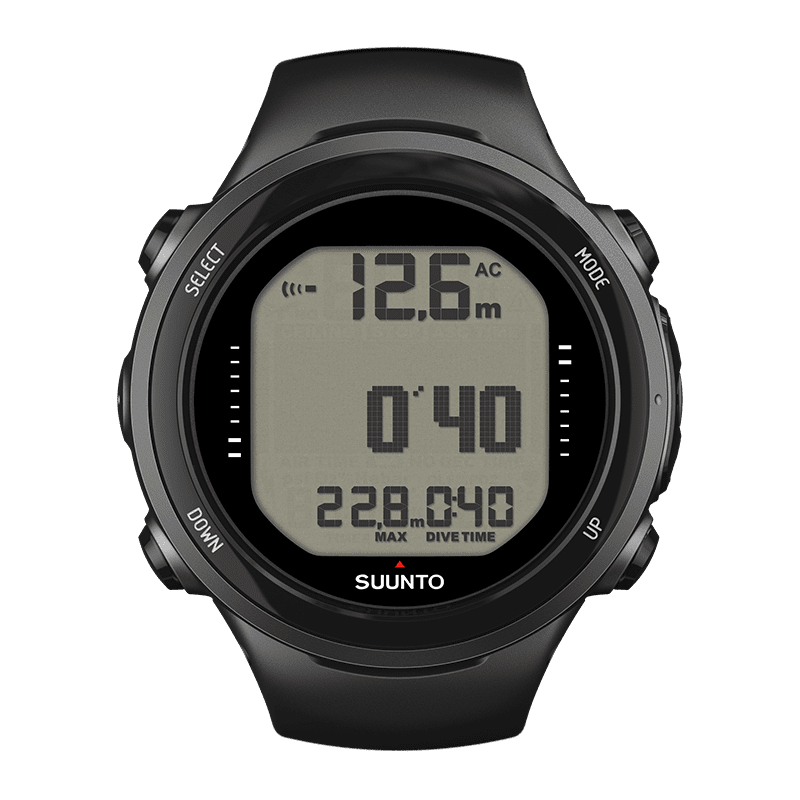
Lower in Suunto’s watch sized diving computer range is the D4i Novo. It’s just cheaper than the Aqualung i1470TC on price, but nearly $200 more expensive than a Deep6 Excursion (which doesn’t have air integration).
The D4i offers acceptable functionality for a watch sized diving computer, but suffers from an antiquated low-resolution LCD matrix screen and not having a rechargeable battery.
Offering just one gas mix, the D4i is firmly a recreational diving computer.
Many divers will attest that the RGBM algorithm is exceptionally conservative; especially on repetitive and multi-day diving; which can be a very positive feature for new divers, but may frustrate those who have built up the experience to know their own tolerances and plan their diving prudently.
Product link:
Product Manual:
Suunto DX Titanium
- Algorithm: Suunto Fused™ RGBM
- PC Link: USB and inductive
- No. Gasses: 8 (o2 5-99% / Helium >95%) or CCR 3 diluents
- Air Integration: 1 transmitter
- Depth Rating: 200m
- Screen Type: LCD matrix (49×22 pixel) with electro-luminescent backlight
- Battery: CR2450 watch battery
- Strap: Titanium
- Materials: Titanium case and bezel with sapphire crystal screen
- Compass: yes
- Price: ~$1600
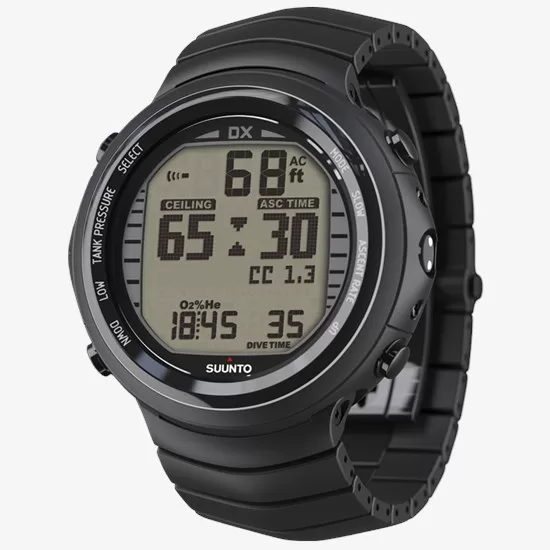
The Suunto DX Titanium is priced at the top of the premium range for a watch sized diving computer, which is shocking because it only offers a LCD matrix screen and a replaceable battery. It has no smartwatch functions, which may make it unattractive compared to similarly priced competitors that seem two generations above in technology.
The main selling feature of this computer is the all-titanium construction and sapphire crystal screen. The Fused RGBM algorithm combines recreational and technical decompression models, switching between the two depending on the dive parameters.
The algorithm is conservative compared to the newer RGBM-2 on the D5 computer. Despite offering trimix, decompression gasses and CCR functionality, the choice of algorithm is liable to make this unpopular with many experienced technical and rebreather divers.
Product link:
Product Manual:
Apple Watch Ultra Oceanic+
- Algorithm: Bühlmann ZHL-16C algorithm
- PC Link: Connects to Apple products
- No. Gasses: 1 (21-40% EANx)
- Air Integration: None
- Depth Rating: 40m / 130ft
- Screen Type: 1.9″ inches” (49 mm) 326px OLED
- Battery: Rechargeable; up to 36 hours smartwatch on land
- Strap: Silicone straps in black, white, aqua, petrol blue, pink and yellow
- Materials: Titanium case with sapphire crystal screen
- Compass: Digital 3D tilt-compensated
- Price: $799.00 to $899.00 for the watch. plus an Oceanic+ app subscription of $9.99 (US) per month, or annually for $79.99 (US)
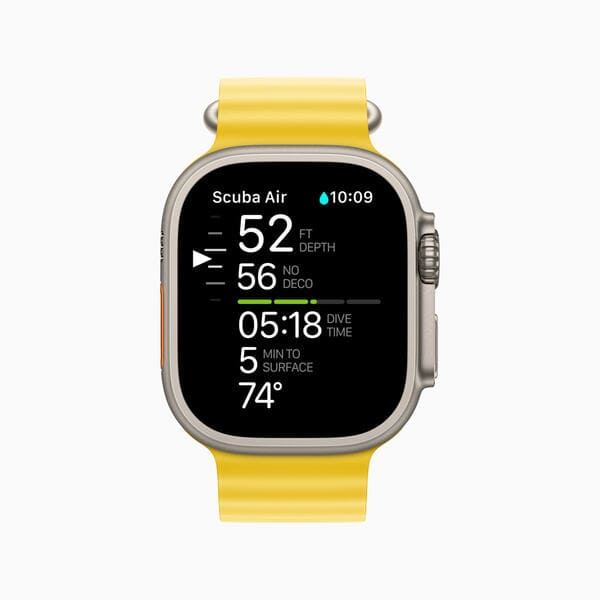
There was a lot of buzz when the Apple Watch Ultra was first promoted as a dive computer. However, the very limited diving functionality means it competes poorly with other options at the same price range. The depth sensor limitation of 40m/130ft is very restrictive and it can only manage 1 gas.
In addition to buying the Apple Watch Ultra, divers have to take out an ongoing subscription to the Oceanic+ app. Overall, this makes it a very expensive choice for a computer with very basic diving functionality. For the cost of a 1 year subscription it is possible to buy and own a 2nd-hand economy-range computer.
Infrequent recreational divers who already own an Apple Watch Ultra might consider installing the Ocean+ app. It could be a cheap option if the subscription is only paid for the month of an annual diving vacation. However, for more advanced or frequent divers, a dedicated diving computer may be the prudent option.
Product link:
About The Author

Andy Davis is a RAID, PADI TecRec, ANDI, BSAC, and SSI-qualified independent technical diving instructor who specializes in teaching sidemount, trimix, and advanced wreck diving courses.
Currently residing in Subic Bay, Philippines; he has amassed more than 10,000 open-circuit and CCR dives over three decades of challenging diving across the globe.
Andy has published numerous diving magazine articles and designed advanced certification courses for several dive training agencies, He regularly tests and reviews new dive gear for scuba equipment manufacturers. Andy is currently writing a series of advanced diving books and creating a range of tech diving clothing and accessories.
Prior to becoming a professional technical diving educator in 2006, Andy was a commissioned officer in the Royal Air Force and has served in Iraq, Afghanistan, Belize, and Cyprus.
In 2023, Andy was named in the “Who’s Who of Sidemount” list by GUE InDepth Magazine.
Purchase my exclusive diving ebooks!
Dive computer FAQs
There are a number of watch-sized dive computers that can be worn as day-to-day timepieces. Some are smart watches with extensive sports, outdoors, and fitness functions.
Best all-around watch computer: Shearwater Teric
Top value for money computer: Garmin G1 Solar
Best economy watch computer: Deep6 Excursion
The best all-around smartwatch for use as a diving computer is the Garmin Descent Mk2. However, the Garmin G1 Solar represents the best value for money.
The Garmin Descent Mk2 and G1 Solar models are both fully-functioning dive computers.
There are many watch-sized dive computers on the market. The Garmin G1 Solar is currently the smallest, with a screen size of less than 1″x1″.
The Garmin Descent Mk2 and G1 Solar are both highly capable smart watches & fully functional diving computers.
Both are fully functional diving computers that use Bühlmann ZHL-16c model. The Teric has more diving functionality, whereas the Descent Mk2 has more sports and smartwatch capability.
Originally posted 2022-11-11 22:51:58.








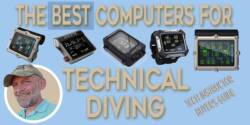







Many thank’s for that for this very compréhensive analyses. For your information Huawei ultimate watch is fitted with a ZHL16 Bühlmann algorythm witch allows OC diving (air, nitrox ans trimix) and apnea with a very clear Amoled screen
What yogur opinion on the Hawei ultimate?. Greetings and congratulations for your blog.